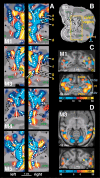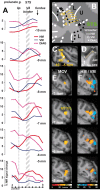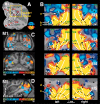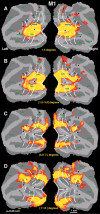The retinotopic organization of primate dorsal V4 and surrounding areas: A functional magnetic resonance imaging study in awake monkeys
- PMID: 12917375
- PMCID: PMC6740456
- DOI: 10.1523/JNEUROSCI.23-19-07395.2003
The retinotopic organization of primate dorsal V4 and surrounding areas: A functional magnetic resonance imaging study in awake monkeys
Abstract
Using functional magnetic resonance imaging (fMRI), we mapped the retinotopic organization throughout the visual cortex of fixating monkeys. The retinotopy observed in areas V1, V2, and V3 was completely consistent with the classical view. V1 and V3 were bordered rostrally by a vertical meridian representation, and V2 was bordered by a horizontal meridian. More anterior in occipital cortex, both areas V3A and MT-V5 had lower and upper visual field representations split by a horizontal meridian. The rostral border of dorsal V4 was characterized by the gradual transition of a representation of the vertical meridian (dorsally) to a representation of the horizontal meridian (more ventrally). Central and ventral V4, on the other hand, were rostrally bordered by a representation of the horizontal meridian. The eccentricity lines ran perpendicular to the ventral V3-V4 border but were parallel to the dorsal V3-V4 border. These results indicate different retinotopic organizations within dorsal and ventral V4, suggesting that the latter regions may not be merely the lower and upper visual field representations of a single area. Moreover, because the present fMRI data are in agreement with previously published electrophysiological results, reported distinctions in the retinotopic organization of human and monkey dorsal V4 reflect genuine species differences that cannot be attributed to technical confounds. Finally, aside from dorsal V4, the retinotopic organization of macaque early visual cortex (V1, V2, V3, V3A, and ventral V4) is remarkably similar to that observed in human fMRI studies. This finding indicates that early visual cortex is mostly conserved throughout hominid evolution.
Figures








Similar articles
-
Second and third visual areas of the cat: interindividual variability in retinotopic arrangement and cortical location.J Physiol. 1980 Feb;299:247-76. doi: 10.1113/jphysiol.1980.sp013123. J Physiol. 1980. PMID: 7381768 Free PMC article.
-
Visuotopic organization and extent of V3 and V4 of the macaque.J Neurosci. 1988 Jun;8(6):1831-45. doi: 10.1523/JNEUROSCI.08-06-01831.1988. J Neurosci. 1988. PMID: 3385477 Free PMC article.
-
Visual field representation in striate and prestriate cortices of a prosimian primate (Galago garnetti).J Neurophysiol. 1997 Jun;77(6):3193-217. doi: 10.1152/jn.1997.77.6.3193. J Neurophysiol. 1997. PMID: 9212268
-
Controversies about the visual areas located at the anterior border of area V2 in primates.Vis Neurosci. 2015;32:E019. doi: 10.1017/S0952523815000188. Vis Neurosci. 2015. PMID: 26581040 Free PMC article. Review.
-
Resolving the organization of the territory of the third visual area: a new proposal.Vis Neurosci. 2015 Jan;32:E016. doi: 10.1017/S0952523815000152. Vis Neurosci. 2015. PMID: 26241553 Review.
Cited by
-
Single-unit recordings in the macaque face patch system reveal limitations of fMRI MVPA.J Neurosci. 2015 Feb 11;35(6):2791-802. doi: 10.1523/JNEUROSCI.4037-14.2015. J Neurosci. 2015. PMID: 25673866 Free PMC article.
-
The case for primate V3.Proc Biol Sci. 2012 Feb 22;279(1729):625-33. doi: 10.1098/rspb.2011.2048. Epub 2011 Dec 14. Proc Biol Sci. 2012. PMID: 22171081 Free PMC article. Review.
-
Monkey cortex through fMRI glasses.Neuron. 2014 Aug 6;83(3):533-50. doi: 10.1016/j.neuron.2014.07.015. Neuron. 2014. PMID: 25102559 Free PMC article. Review.
-
Functional architecture of retinotopy in visual association cortex of behaving monkey.Cereb Cortex. 2005 Apr;15(4):460-78. doi: 10.1093/cercor/bhh148. Cereb Cortex. 2005. PMID: 15749989 Free PMC article.
-
Charting the lower superior temporal region, a new motion-sensitive region in monkey superior temporal sulcus.J Neurosci. 2006 May 31;26(22):5929-47. doi: 10.1523/JNEUROSCI.0824-06.2006. J Neurosci. 2006. PMID: 16738235 Free PMC article.
References
-
- Andersen RA, Asanuma C, Essick G, Siegel RM ( 1990) Corticocortical connections of anatomically and physiologically defined subdivisions within the inferior parietal lobule. J Comp Neurol 296: 65-113. - PubMed
-
- Bartels A, Zeki S ( 2000) The architecture of the colour centre in the human visual brain: new results and a review. Eur J Neurosci 12: 172-193. - PubMed
-
- Ben Hamed S, Duhamel JR, Bremmer F, Graf W ( 2001) Representation of the visual field in the lateral intraparietal area of macaque monkeys: a quantitative receptive field analysis. Exp Brain Res 140: 127-144. - PubMed
-
- Blatt GJ, Andersen RA, Stoner GR ( 1990) Visual receptive field organization and cortico-cortical connections of the lateral intraparietal area (area LIP) in the macaque. J Comp Neurol 299: 421-445. - PubMed
-
- Boussaoud D, Ungerleider LG, Desimone R ( 1990) Pathways for motion analysis: cortical connections of the medial superior temporal and fundus of the superior temporal visual areas in the macaque. J Comp Neurol 296: 462-495. - PubMed
Publication types
MeSH terms
LinkOut - more resources
Full Text Sources
Miscellaneous
